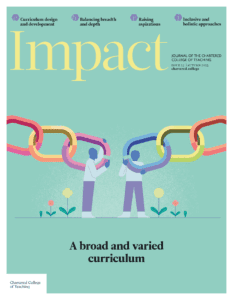Curriculum design at Key Stage 3: Supporting primary to secondary school transition

VICTORIA COOK, LEAD RESEARCHER, CHARTERED COLLEGE OF TEACHING, UK
This article was produced as part of a project funded by the Comino Foundation.
Introduction
A 2015 OfstedThe Office for Standards in Education, Children’s Services and Skills – a non-ministerial department responsible for inspecting and regulating services that care for children and young people, and services providing education and skills report entitled ‘Key Stage 3: The wasted years?’ concluded that Key Stage 3 needs to become a higher priority for secondary school leaders, to ensure that the time is used effectively to develop students’ learning. In particular, the report painted a varied landscape with regard to transition arrangements from primary to secondary schools. While examples of effective collaboration between primary and secondary schools were identified, inspectors concluded that students’ prior learning was not being sufficiently built upon in many secondary schools, with repetition of work completed in primary school:
From the start of Year 7, teachers’ expectations of what pupils can achieve are often too low. This can have a detrimental effect on the rate at which they make progress during the first years of their secondary education.
Ofsted, 2015, p. 27
The same report also noted that students’ pastoral needs were often prioritised over their academic needs at the point of transition, which can have a particularly negative effect on the progress and engagement of the most able. Research suggests that children face a variety of academic, social and emotional adjustments in the transition from primary to secondary school, and these adjustments are likely to interact in complex ways that are not yet fully understood (Harris and Nowland, 2021). It is therefore important that transition from Key Stage 2 to 3 focuses equally on students’ academic and pastoral needs, if all students are to be fully supported to make successful adjustments to secondary school.
Our research
But how has the landscape changed since Ofsted’s report was published? The Chartered College of Teaching, funded by the Comino Foundation, has recently undertaken research into curriculum-making at Key Stage 3. An online survey was developed and shared with members and followers of the Chartered College of Teaching via newsletters and social media, as well as Comino Schools via their communication channels, between 11 December 2023 and 21 January 2024. As part of this survey, those working in secondary or all-through settings were asked to elaborate on the strengths (n = 168) and weaknesses (n = 174) of their curriculum design at Key Stage 3. These responses were analysed inductively following the six phases of thematic analysis described by Braun and Clarke (2006).
A varied landscape
In schools where transition was identified as a strength of curriculum design, there was a clear emphasis on providing a cohesive curriculum:
The Key Stage 3 curriculum is cohesive with Key Stage 2 (we have an annual “in-touch” contact with our feeder primary schools to share transition resources, as well as our curriculum guide).
Middle leader
This cohesive approach avoids work being repeated, which can lead to children becoming frustrated (Jindal-Snape, 2009). Such an approach is reminiscent of the successful cross-phase partnerships established between primary and secondary schools that were identified by Ofsted in their 2015 report. Such partnerships enable Key Stage 3 teachers to build on pupils’ prior knowledge, understanding and skills:
Transitioning from Key Stage 2 to 3, we did a lot of work with feeder schools looking at what knowledge the students came with and how to get them to where they needed to be at the end of Key Stage 3.
Senior leader
While the approach used to build on Key Stage 2 will inevitably vary between schools, all-through schools may have a particular advantage when seeking to establish close working relationships with their primary colleagues:
In an all-through school, the strength is on the transition points and the continuity of skill development from one key stage to the next. Having this clearly mapped has allowed teachers to focus on individual learners and meet their needs. There is less wasted time in transition years, as everyone is clear of what has gone before and what is to come.
Senior leader
However, this does not necessarily mean that transition was a strength of every all-through school that took part in the research:
Not taking full advantage of the opportunity that our all-through school presents [is a weakness] so that it isn’t clear how we build… for example, if you take children’s writing, in primary the emphasis is on the child as a writer – honing the craft of writing, often in a creative way. But in Key Stage 3, because of the back-planning from GCSE, we tend to think of the child as a consumer of others’ writing – we only want to know how they are responding, not creating.
Senior leader
The importance of ongoing dialogue, both between and within schools, is therefore vital if pedagogical and curricular continuity is to be achieved. However, our findings suggest that the pressure of high-stakes examinations at the end of Key Stage 4 may lead to a focus on backward-planning from GCSE, rather than building on Key Stage 2.
In schools where transition was identified as a weakness of curriculum design at Key Stage 3, the repetition of work from primary school was noted as a significant weakness:
Sometimes [there is] a lack of joined-up thinking between Key Stage 2 and Key Stage 3, so that there can be repetition of knowledge and lack of skills progressions.
Senior leader
A lack of curriculum continuity between primary schools was one reason why content was repeated in Key Stage 3:
We are secondary-based, so our problem is that Key Stage 2 do not focus on science (each school pupils come from varies wildly in what they have studied) and so a lot of Key Stage 3 is catch-up.
Middle leader
However, it may also be the case that the information provided by primary schools is not being used effectively to inform curriculum planning at Key Stage 3:
Not using the information that is available about what knowledge and skills children come from primary with [is a weakness].
Headteacher
These findings correspond with another key finding from a different question in our survey (n = 238): What do you consider to be the main challenges for curriculum design at Key Stage 3? One of the main challenges identified was how to ensure that the curriculum builds on – rather than repeats content from – Key Stage 2 (n = 41).
Given the enduring inconsistencies with regard to transition arrangements in different schools, in addition to the challenges faced by curriculum designers at Key Stage 3, there is a clear need for professional development interventions targeting pedagogical and curricular continuity. However, a recent systematic review of 26 experimental and quasi-experimental studies of school-based interventions to prepare and support student social-emotional and educational outcomes in high-income OECD member countries identified a lack of research exploring transition interventions that specifically target teachers (Beatson et al., 2023).
Transition interventions
School-based interventions designed to increase positive outcomes for all children may be delivered prior to students moving from one school to another (‘pre-transfer’ activities) or delivered in the new school setting (‘post-transfer’ activities) (Bagnall and Jindal-Snape, 2023). These preparatory and support activities can be broadly categorised as focusing on social-emotional wellbeing, teaching and learning or school administration (Beatson et al., 2023). These interventions may be delivered to all students or targeted at specific subgroups of students, such as those with emotional, behavioural and physical support needs, who may be at greater risk of a difficult transition (Harris and Nowland, 2021).
Despite the range of activities designed to improve student transitions, there is a lack of clarity around which interventions are most successful and feasible to deliver, as well as their suitability for different student populations (Beatson et al., 2023). The systematic review conducted by Beatson and colleagues found that most interventions demonstrated a positive effect on at least one outcome. Pre-transfer interventions designed to develop social-emotional and coping skills over several months generally had positive effects; however, the results indicated that more intensive programmes may be required for students from disadvantaged backgrounds. In comparison, there was stronger evidence that post-transfer interventions involving relatively brief, low-cost and scalable mindset activities, targeting academic and social belonging, improved student outcomes, with (some large) positive effects evident for students from disadvantaged backgrounds.
Amid this lack of clarity in the evidence base, our findings suggest that there is a need to support schools to understand what best practice looks like when students’ pastoral and academic needs are being supported:
There are no blueprints for how to successfully manage curricular transitions. There are no policies (aside from perhaps some local ones) and no guidance or examples of best practice.
Education consultant
In particular, understanding how schools design and implement professional development interventions targeting pedagogical and curricular continuity would help to fill a notable gap in the evidence base.
Conclusions and future research priorities
The landscape with regard to transition arrangements from primary to secondary schools appears as varied today as it was at the time of Ofsted’s 2015 report. There is a discernible need to identify and share examples of best practice among colleagues to help to create a more equitable landscape and understand how evidence-informed approaches to transition are being implemented and evaluated.
In terms of future research, Harris and Nowland (2021) argue that it is important to consider the multiplicity of factors influencing transition. They argue that future research needs to explore how the academic, social and emotional aspects of the primary–secondary school transition interact, in addition to exploring ‘hidden factors’ such as gender, disability, race and ethnicity. This is especially important if we are to understand and overcome the additional barriers faced by marginalised groups during transition.
Further support
The Education Endowment Foundation (2021) has produced an evidence-based transitions tool that contains reflective questions for school leaders to support transition decisions. Huntingdon Research School (2024) has summarised key strategies for supporting literacy transition from Key Stage 2 to Key Stage 3.
- Bagnall CL and Jindal-Snape D (2023) Child self-report measures of primary–secondary transition experiences and emotional wellbeing: An international systematic literature review. International Journal of Educational and Life Transitions 2(1). DOI: 10.5334/ijelt.35.
- Beatson R, Quach J, Canterford L et al. (2023) Improving primary to secondary school transitions: A systematic review of school-based interventions to prepare and support student social-emotional and educational outcomes. Educational Research Review 40(1): 100553.
- Braun V and Clarke V (2006) Using thematic analysis in psychology. Qualitative Research in Psychology 3(2): 77–101.
- Education Endowment Foundation (2021) School transitions tool – A trio of challenges. Available at: d2tic4wvo1iusb.cloudfront.net/production/documents/news/Transition_tool.pdf?v=1758013208 (accessed 17 September 2025).
- Harris J and Nowland R (2021) Primary–secondary school transition: Impacts and opportunities for adjustment. Journal of Education & Social Sciences 8(2): 55–69.
- Huntington Research School (2024) Strategic planning for effective literacy transition from KS2 to KS3. Available at: researchschool.org.uk/huntington/news/strategic-planning-for-effective-literacy-transition-from-ks2-to-ks3 (accessed 17 September 2025).
- Ofsted (2015) Key Stage 3: The wasted years? Available at: assets.publishing.service.gov.uk/government/uploads/system/uploads/attachment_data/file/459830/Key_Stage_3_the_wasted_years.pdf (accessed 1 February 2024).










